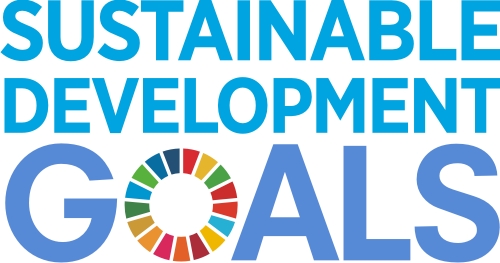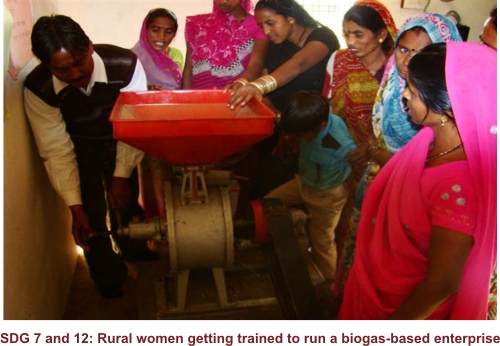Women Impacting SDGs and
SDGs Impacting Women
Inclusive
Development and Sustainable Development are the new priority areas in the
current time. Commitment and planning is proceeding in the direction of
'bottom up' approach. India adopted the Sustainable Development Goals (SDGs)
comprising of 17 goals and 169 targets in 2015. One of the main r easons
behind adopting these goals was to make India tread on a sustainable path –
economically, socially and environmentally.
easons
behind adopting these goals was to make India tread on a sustainable path –
economically, socially and environmentally.
India is a country of diversity where there is dynamism reflected in terms of globalisation and fast paced adoption of new technologies and lifestyle changes. At the same time, there is importance of practice of one's culture and traditions. Attainment of SDGs in India would impact diverse groups differently. This article is an attempt to delve into the question of how SDGs influence lives of women and vice versa, keeping in light the contours of our society pertaining to culture, family norms, economic and social inequality and spatial inequality.
In order to understand the SDG goals according to the lens of gender equality, an inclusive understanding of the term is a pre-requisite. Gender equality doesn't imply a preferential approach but rather it is based on the principles of equity and collaboration. From ancient times, women have held a sub optimal position is society as compared to men. This was evident through the practices of Sati and Purdah system. The assertion for rights of women has been seen in the form of pertinent voices demanding the right for education of women. In recent times, the strive for equality is demonstrated through the demand for political and civil society representation of women. In the Indian context, one of the means of achieving gender equality can be through gender equity, which means 'giving the unequal, chances to be equal'. The state is an agent for assimilation of these changes and thereby through continuous efforts it is trying to foster gender equality through actions such as the passing of the 73rd Constitutional Amendment, abolition of Triple Talaq and revisiting of adultery laws. While reflecting upon the SDG goals, principles of equality induced through 'equity, inclusivity and collaboration' have to be taken into consideration.
Goal 1: No Poverty
Looking at the degree of marginalisation, poor women are more susceptible to poverty. However, government figures are positive since the participation of women in MGNREGA has increased. Also schemes which involve Direct Benefit Transfers (DBTs) like PM Ujjwla Yojna and Housing for All 2022 have a mandate of transferring DBTs into the account of women. But, dominance of patriarchy and lack of decision making opportunity on economic matters makes the situation difficult. Efforts have to be made in this direction to make us achieve the 'No Poverty' goal by 2030.
Goal 2: Zero Hunger
As per the National Family Health Survey (NFHS-4) data, 53% of women are anemic and 22% of women have below normal BMI. This data is an indicator of lack of proper diet which can be attributed to hunger and poverty. Thus, in order to tackle this problem, local institutions like Integrated Child Development Services (ICDS) are being strengthened. Emphasis on distribution of iron and folic acid tablets is being given importance. Also, DBT transfers through Public Distribution System (PDS) are being done in the name of the woman of the household.
Goal 3: Good Health and Well Being and Goal 6: Clean Water and Sanitation
Maternal Mortality Rate has fallen from 74 in 2005-2006 to 50 in 2015-2016. Institutional deliveries have also increased from 38.7% to 78.9% in the given period. These positive figures reflect an advancement towards Goal 3. However, out of pocket expenditure and unavailability of sufficient primary care centres across the rural pockets of India makes the situation difficult. This problem is further coupled with anti-drug resistance and improper maintenance of hospitals in rural pockets as was demonstrated by the Gorakhpur incident in Uttar Pradesh where lack of oxygen cylinders led to the death of a number of children. But, efforts are being made in this direction to address the short fall with active civil society and media engagement. Efforts to strengthen WASH facilities are also being pursued aggressively.
Goal 4: Quality Education and Goal 5: Gender Equality
Education is a process by which women can find upward mobility in society.
This is the reason that historically also efforts were made in this
direction by social reformers like Ishwar Chandra Vidyasagar and Savitribai
Phule. Good quality education is a skill in itself as it fosters self-esteem
and awareness which propels one to achieve success. Progress is seen with
increase in the literacy rate of women to about 68% and increase in the bank
accounts owned by women. Direction towards gender equality can be seen in
terms of more and more women taking up careers which were earlier male
dominated. For instance, recently I NVS
Tarini had an all women navy crew.
NVS
Tarini had an all women navy crew.
SDG 7: Affordable and Clean Energy, SDG 11: Sustainable Cities and Communities and SDG 12: Responsible Production and Consumption
Access to clean energy is critical for achieving sustainability. In rural communities, there is prevalence of the use of firewood for cooking which is highly unsustainable and women are directly at health risk because of this. In order to address this problem, PM Ujjwala Yojna was launched under which by far 2 million households have been covered. Also, grassroots level innovation like the 'Jugad' technology are being scaled up. For instance, in Andhra Pradesh women have set up Krushi marts where they sell items made up of recycled materials.
SDG 8: Decent Work and Economic Growth, SDG 9: Industry, Innovation and Infrastructure and SDG 10: Reduced Inequalities
Persistent efforts have been made in the direction of ensuring decent work conditions for women and to absorb 50% of women into the workforce. The direction in this regard pertains to Equal Remuneration Act 1976 for ensuring equality of wages, Vishakha Guidelines for protection against sexual harassment and Maternity Benefit Bill, 2016 providing women sufficient time to join work after delivery and thereby retain their place in the workforce. These steps have improved the participation of women in the market.
SDG 13: Climate Action, SDG 14: Conserve Life Below Water and SDG 15: Protect Life on Land
Women have always taken a lead when it comes to protecting the environment. This dates back to the Chipko Movement where participation of women saved trees from being felled. Similarly, women have been active as community leaders in order to adopt climate change mitigation strategies. India is also witnessing a trend of large number of women undertaking marine economic activities such as fishing and aqua culture, due to which there has been an increase in fisherwomen self-help groups.
SDG 16: Peace, Justice and Strong Institutions and SDG 17: Partnerships for the Goals
Institutions are making the role of women strong and vice versa. For
instance, women hold political positions in Gram Panchayats thereby making
the local government inclusive and strong. On the level of partnerships too,
the focus of many international conferences like Global Entrepreneurship
Summit, 2017 was dedicated to women first.
Therefore, the process of SDG impacting the lives of women and women
influencing the goals of SDGs are mutually dependent and can be seen in the
light of societal dynamics.
■
Trina Das
tdas@devalt.org
References:
1. GOI. Voluntary National Review Report On The Implementation Of
Sustainable Development Goals (Rep.).doi:http://niti.gov.in/ writereaddata/files/India%20VNR_Final.pdf.
2. http://in.one.un.org/page/ sustainable-development-goals/.
3. http://rchiips.org/nfhs/pdf/ NFHS4/India.pdf.